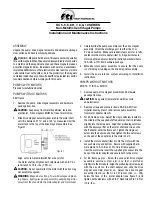
l
Make sure that the vacuum pump cannot inadvertently or
intentionally be used as a support for heavy objects
l
Make sure that the vacuum pump cannot be hit by falling objects
l
Make sure that the vacuum pump is at least 0,5 m away from any
wall to ensure sufficient cooling
l
Make sure that no temperature-sensitive components (plastics,
wood, cardboard, paper, electronics) come into direct contact with
the hot surface of the vacuum pump
l
Make sure that the installation site or assembly area is ventilated in
such a way that adequate cooling of the vacuum pump is
guaranteed
CAUTION
During operation the surface of the vacuum pump can exceed
temperatures of 70°C.
Risk of burns!
l
Make sure that the vacuum pump cannot be touched inadvertently
during operation, provide a guard if necessary
l
Make sure that the oil sight glasses (OSG, 220/ 222) remain easily
accessible
If the oil change is meant to be performed on site:
u
Make sure that the oil drain plugs (ODP, 252/ 262 or 610)
and the oil filler plugs (OFP, 250/ 260) remain easily accessible
Configuration of the pump:
u
Vertical gas flow
Vertical gas flow has the advantage of self-cleaning of the cylinder
during operation.
Suction Connection
CAUTION
Do not put hands into the inlet aperture.
Risk of body damage!
CAUTION
The ingress of foreign particles or liquids can destroy the vacuum
pump.
In case the inlet gas contains dust or other foreign solid particles:
u
Make sure that a suitable filter is installed upstream of the
vacuum pump
l
Make sure that the suction line fits the suction flange/ gas inlet of
the vacuum pump
l
Make sure that the vacuum pump is switched off and cannot
accidentally be switched on again
When using pipes :
u
Make sure that the pipe does not exercise any pressure on the
vacuum pump’s connection, use bellows if necessary
If two or more vacuum pumps work on the same suction line, if the
volume of the vacuum system is large enough to draw back oil after
having been switched off, or if the vacuum must be maintained after
switching off the vacuum pump :
u
Provide a manual or automatic operated valve (non-return
valve) in the suction line
(the installed non-return valve inside the suction connection is
not meant to be used for this purpose!)
If the vacuum pump is intended to be used for the drawing of gases
that contain limited quantities of condensable vapour:
u
Provide a shut-off valve, a drain line and a drain tap in the
suction line, so that condensates can be drained from the
suction line
l
Make sure that the suction line does not contain foreign matter,
e.g. welding slag
Discharge connection
CAUTION
Do not put hands into the outlet aperture.
Risk of body damage!
The following guidelines for the discharge line do not apply if the
drawn air is discharged into the environment directly at the vacuum
pump.
l
Make sure that the discharge line fits the gas discharge of the
vacuum pump
When using pipes:
u
Make sure that the pipe does not exercise any pressure on the
discharge connection, use bellows if necessary
l
Make sure that the discharge line’s diameter over its entire length
is at least as large as the diameter of the gas discharge of the
vacuum pump
In case of very long discharge lines, it is advisable to use a larger
diameter piping in order to avoid a loss in efficiency and an overload
on the vacuum pump. For advice please contact your local Busch
representative!
l
Make sure that the discharge line either slopes away downwards
from the vacuum pump or provide a liquid separator or a drain line
with a drain tap, so that no liquids can be drawn back into the
vacuum pump
WARNING
Discharge lines made from non-conducting material can build up
electrostatic charge.
Electrostatic discharge can lead to explosion of potentially present
oil mist.
The discharge line must be made of conducting material or
provisions must be made against electrostatic discharge.
Electrical connection/ Controls
l
Make sure that the regulations acc. to the EMC-Directive
2004/108/EC as well as the EN-standards, electrical and
occupational safety directives and the local or national regulations,
respectively, are complied with (this is in the responsibility of the
designer of the machinery into which the vacuum pump is to be
incorporated; see also the note in the EU-Declaration of
Conformity)
l
Make sure that the power supply is compatible with the
specification on the nameplate of the drive motor
l
Make sure that an overload protection according to EN 60204-1 is
provided for the drive motor
l
Make sure that the drive of the vacuum pump will not be affected
by electric or electromagnetic disturbance from the mains; if
necessary contact the Busch service for advice
In case of mobile installation:
u
Make sure that the vacuum pump is switched off and cannot
accidentally be switched on again
l
If the Roots blower is used in a vacuum system where a vacuum
pump is connected upstream, the vacuum pump can only be
started up after the primary pump has gone into operation.
Installation and Commissioning
Page 6
Содержание WY 4500 C
Страница 13: ...Exploded drawing Page 13 Exploded drawing ...
Страница 20: ......
Страница 22: ...Note ...
Страница 23: ...Note ...







































